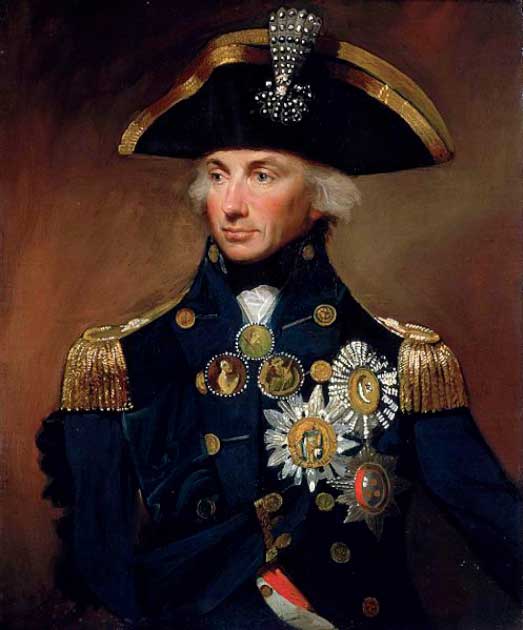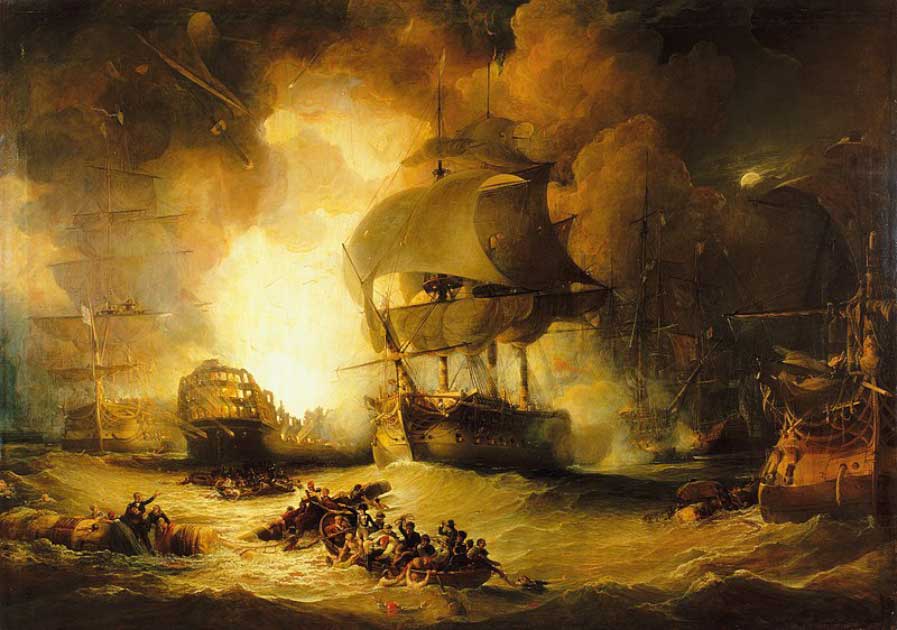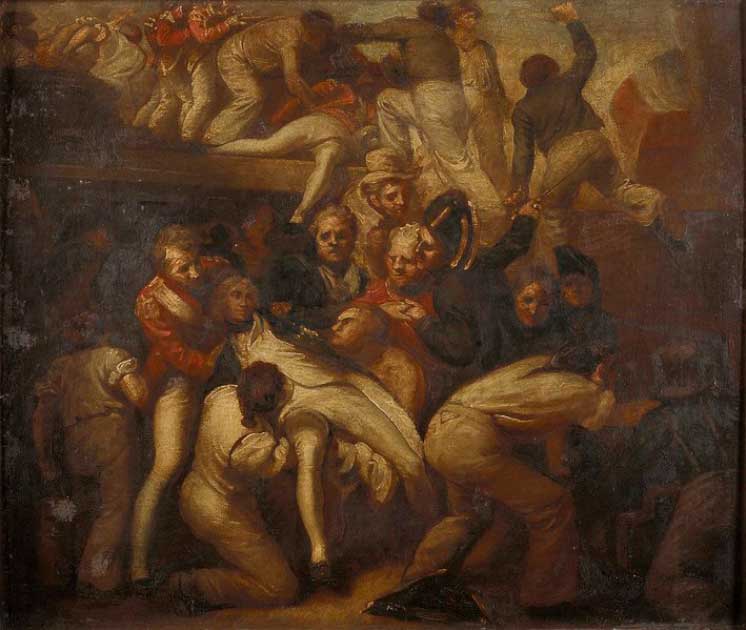Horatio Nelson is almost certainly the most famous sailor from the British Isles, if not the world. Born in 1758 in Norfolk, he rose to command His Majesties fleets in a series of daring, innovative and wildly successful naval battles against the French.
Nelson’s life was one of constant dynamism, as under his guidance the British navy rose to dominate the world, and in fighting the French found the beginnings of Empire as well. His life may have been cut short, but in his actions against the French we see the full fledged genius which made him famous.
Here is Nelson’s career, told in the battles he witnessed and won.
1. HMS Abermarle
In 1778 Nelson received his first command at the age of 20. Already an experienced sailor kept busy with convoy escort and exploratory duties, particularly in search of the fabled Northwest Passage, he was now in command of ships of his own.
But is would be with HMS Abermarle, commanded by Nelson from 1781, that he would first make his mark. Not the finest of ships, Nelson’s early encounters with the French were duly hampered and proved abortive.
His one great action in Abermarle was in fact only in escape. A French flotilla commanded by the formidable Marquis de Vaudreuil had orders to hunt down isolated English ships and attack them. In August 1782 the French sighted Nelson, and it was only after a prolonged chase and some fine seamanship by the English that Nelson was able to escape.
2. The Mediterranean and the Invasion of Corsica
Nelson’s time in the 1790s was somewhat quite. France was at peace and the sailor struggled to find an active commission that would take him. However that all changed in 1792 when the French annexed Belgium and the Netherlands, and Nelson was recalled to active service and given the 64 gun HMS Agamemnon as his command.

On 1 February 1793 France declared war and Nelson was tasked with disrupting French interests in the Mediterranean. After hunting for the French for months Nelson finally found a squadron of five French vessels supporting an invasion of Corsica. Despite being heavily outnumbered, Nelson attacked without hesitation.
- Napoleon’s Downfall: How did the Little Dictator Lose at Waterloo?
- John Kendrick: Killed by his own Gun Salute?
The Agamemnon was heavily damaged but inflicted much damage in return. Nelson was forced to retire, but returning with reinforcements he was able to blockade Corsica. A useful port close the French mainline, Nelson would end up taking the entire island, losing the sight in one eye in the process.
3. The Battle of Genoa (1795)
For all his success, Nelson had yet to experience a fleet action first hand. This would all change in 1795 when, seeking diplomatic relations with Genoa, the English fleet encountered the French sailing for Corsica.
Although the French seemed unwilling to join combat, the fleets met on 14 May at the Battle of Genoa. Nelson joined the other British ships in firing on a heavily damaged Ça Ira, an enormous 84 gun French ship of the line. Both the Ça Ira and the Censeur towing her were captured, with Nelson taking the Censeur as a prize.
However the remaining French were able to escape and the action was only a minor victory for the English. However, alongside the Battle of the Hyères Islands fought four months later, this established Nelson as a man who had seen action and who had prosecuted combat.
4. Battle of Cape St Vincent (1797)
Nelson’s next great battle would come two years later at the entrance to the Mediterranean, and at the start of the Anglo Spanish war. Now commanding the HMS Captain, Nelson was positioned towards the rear of the line of ships and realized he was unlikely to see any direct action.
Rejecting this, Nelson disobeyed orders and broke from the line with his ship, bearing down on the three huge Spanish ships in the vanguard of the formation. Assisted with one other ship, Nelson was still heavily outgunned.
Nelson himself led a boarding party to take a Spanish ship, and when a second came alongside to assist and became entangled, he promptly captured her as well. His actions, although publicly frowned upon, were considered instrumental to the British success, and his daring was noted.
5. Battle of the Nile (1798)
After several more actions against the Spanish, during which Nelson lost an arm, he returned to fighting the French directly with the Mediterranean campaign of 1798. Here he won perhaps his most audacious victory, and were it not for Trafalgar this would be by far his most famous.
- The Great Stock Exchange Fraud: Lord Cochrane’s Napoleonic Lies?
- Fireships in the Night: How was the Spanish Armada Defeated?
The French fleet had anchored off the Nile delta, in a line with their guns arms and facing out to sea. However Nelson’s ships positioned themselves between the French vessels at anchor and the land, firing on them at point blank range and facing little return shot.

Only two ships of the line and two frigates escaped on the French side. Napoleon was trapped in Egypt, his eastern ambitions ruined by the destruction of his fleet. As a strategic victory it was unparalleled in Nelson’s career, and he was ennobled as Baron Nelson of the Nile.
6. The Battle of Copenhagen (1801)
By now the British were dominating the seas around Europe, but other purported Allies were unhappy at their merchant vessels being searched. When a proposed British blockade of the Baltic was resisted by European powers including Denmark, Nelson advocated going for the throat with an assault on Copenhagen.
After a failed first attack, Nelson was signaled from his command on board HMS Elephant that retreat was advisable. However he famously held his telescope to his blind eye and stated that he saw no signal, allowing the attack to continue.
After three hours and ceasefire was called by both sides. Nelson went into the city the next day to negotiate the treaty, which saw an armistice, continued British presence in the Baltic, and Nelson being made a Viscount.
7. The Battle of Trafalgar (1805)
Trafalgar was not so much the culmination of a life at sea for Nelson as a triumphant return after years of shore leave. It would be two years after Copenhagen before he returned to sea, given command of the Mediterranean fleet with the first rate HMS Victory as his flagship.
Trafalgar is what he is most remembered for. Rejecting standard military tactics once again, Nelson drove his fleet in two columns straight at the French line of ships. The British endured withering cannon fire but were able to push on and bisect the French line, sowing chaos.

Nelson’s victory was at the front of one of the columns, and took heavy damage. However just as the battle was won, Nelson was shot by an unknown French sniper from the rigging of an enemy ship. Aged 47, the greatest naval hero of the British Isles was dead.
Top Image: Nelson’s flagship HMS Victory at the Battle of Trafalgar. Source: JMW Turner / Public Domain.
By Joseph Green